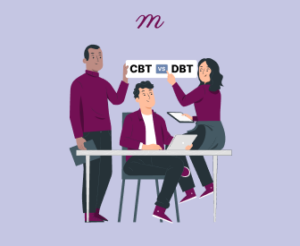Confidentiality is the cornerstone of the therapeutic relationship, offering clients a safe space to explore their most intimate thoughts and feelings without fear of judgment or exposure. Confidentiality is foundational to the trust required for effective therapeutic work. However, there are specific, carefully defined circumstances under which a therapist may ethically and legally break confidentiality. Therapists (and their clients) must understand these exceptions to ensure safety and navigate legal and ethical issues. This article explores these exceptions.
Risk of Harm to Self or Others
One of the most important exceptions to this rule is when there is a risk of harm to the client or others. Legal and ethical frameworks governing mental health professionals recognize this exception, which requires therapists to make sometimes difficult decisions to uphold their duty of care.
When a client expresses suicidal thoughts or plans or indicates they plan to harm someone else, the therapist is faced with the obligation of respecting client confidentiality and preventing harm. Professional codes of ethics and laws in many jurisdictions offer guidance on handling complex situations that warrant a breach of confidentiality.
Therapists are generally required to take the least invasive action necessary to ensure safety. This might involve creating a safety plan with the client or seeking their consent for hospitalization. However, if the risk is imminent and the client refuses voluntary measures, the therapist may have to follow specific steps.
Steps to Prevent Harm
- Conduct a Risk Assessment. The first step is a thorough risk assessment to determine the immediacy and severity of the threat. This involves evaluating the client’s intentions, means, and plans to carry out the threat.
- Seek Consultation. Therapists may consult with colleagues or legal advisors to navigate the decision-making process and ensure they act within legal and ethical boundaries.
- Warn Potential Victims. If a direct threat to a specific individual exists, the therapist may be required to warn the intended victim. This is known as the “duty to warn,” established by cases like Tarasoff v. Regents of the University of California, which mandates therapists take reasonable steps to communicate the threat to the intended victim and law enforcement.
- Involve Law Enforcement or Seek Hospitalization. If there is an imminent risk of harm, the therapist may need to contact law enforcement or arrange for the client’s hospitalization. This is a difficult decision, but it may be necessary to save lives.
- Ensure Precise and Thorough Documentation. The therapist must document their decision-making process, the information leading to their concerns, consultations with colleagues, and any steps to prevent harm. This documentation can be vital if there is legal scrutiny or ethical review.
The therapist must balance the imperative of client privacy with the need to prevent harm, navigating these situations with sensitivity, ethical judgment, and adherence to legal standards. This often involves complex decisions and actions but is essential to safeguard individual and public safety.
Abuse or Neglect of Vulnerable Individuals
The mandate to report abuse or neglect is an exception to the confidentiality usually upheld between therapists and their clients. This mandate applies to mental health professionals who, through the course of their work, may become aware of situations where children, the elderly, or individuals with disabilities are being abused or neglected. The duty to report such information is grounded in the ethical principle of non-maleficence, which obliges therapists to prevent harm and protect those who cannot protect themselves.
The legal requirement for therapists to report suspected abuse or neglect varies by jurisdiction but generally applies across the United States and in many other countries. Mental health professionals must report to local child protective services, adult protective services, or other appropriate authorities when they believe that a vulnerable person is being harmed or is at risk of harm.
This mandate overrides the therapist-client confidentiality agreement because the welfare and safety of vulnerable individuals are considered paramount. Therapists are required to report even suspicions of abuse or neglect – not just confirmed instances. This approach is designed to ensure that potential cases of abuse or neglect are investigated by authorities with the expertise to assess and intervene as necessary. Therapists can follow these steps.
The Reporting Process
- Identification of Abuse or Neglect. Therapists must be vigilant in identifying signs of abuse or neglect, which may include physical injuries, emotional distress, or signs of neglect in vulnerable clients or stories shared by clients about others.
- Immediate Reporting. Once a therapist suspects abuse or neglect, they are typically required to report their concerns to the appropriate authorities as soon as possible, often within a specified timeframe (e.g., within 24 hours).
- Without Client Consent. This reporting is done without consent from the client, or the person being reported. The priority is the safety and well-being of the at-risk person.
- Anonymity and Support. In many jurisdictions, the reporter’s identity is kept confidential. Therapists may also support the client or the individual at risk throughout the reporting process within the boundaries of the law.
- Documentation. Therapists must document their observations, the content of the disclosure, and the steps taken to report the abuse or neglect. This documentation is critical for legal and ethical accountability.
The duty to report abuse or neglect places therapists in complex ethical positions. They must maintain client confidentiality while fulfilling their legal and ethical obligations to protect vulnerable individuals. Therapists must be knowledgeable about the signs of abuse and neglect, understand their legal obligations, and be prepared to act quickly and decisively.
In practice, therapists provide clients with information about the limits of confidentiality at the start of therapy – including the obligation to report abuse or neglect. This transparency helps manage expectations and clarifies the therapist’s role as a mandated reporter.
The ethical commitment to protecting society’s most vulnerable members underscores the importance of mandated reporting laws. By requiring therapists and other professionals to report suspected abuse or neglect, society aims to prevent harm, provide necessary interventions, and support the welfare and rights of children, the elderly, and individuals with disabilities.
Legal Proceedings
In legal proceedings, client-therapist confidentiality can be challenged and, in some instances, overridden. This occurs when a court deems the information held by a therapist critical to a legal case, such as in custody disputes, divorce proceedings, or other litigation. The intersection of legal requirements and ethical duties places therapists in a position where they must navigate the delicate balance of client confidentiality and the legal system’s demands.
A therapist may be compelled to disclose client information under a court order or subpoena. A court order is a directive from a judge requiring the therapist to provide testimony or documents related to a client’s mental health. Subpoenas are legal documents that command someone to produce documents or testify on a matter. Not all subpoenas necessarily result in a breach of confidentiality, and therapists can challenge them if they believe complying would harm the client or the therapeutic relationship.
When facing a legal mandate to disclose client information, therapists are ethically obligated to consider the least harmful means of compliance, including:
- Attempting to minimize disclosure. Therapists should seek to limit the amount of information disclosed, focusing on only what is directly relevant to the legal question. This might involve negotiating with the court or the parties to narrow the scope of what is disclosed.
- Notification to the client. Therapists must inform clients about receiving a court order or subpoena if doing so does not violate the law or court order. This allows the client to object to the disclosure or to be prepared for the potential consequences.
- Seeking legal counsel. Therapists should consult with legal professionals to understand their rights and obligations and to explore all options for protecting client confidentiality. This may include filing a motion to quash (or invalidate) a subpoena if it is believed to be overly broad or if it would cause significant harm to the client.
In custody disputes, the information a therapist provides about a client’s mental health, parenting abilities, and interactions with their children can be pivotal. Courts often consider such information when determining the best interests of the child. Therapists may be asked to provide records, testify about their observations, or offer professional opinions on the client’s mental health and its implications for custody and parenting.
Therapists must navigate the above situations with a deep understanding of their professional and legal responsibilities, ensuring they comply with legal requirements while upholding their ethical duty to their clients. Therapists must consider the following:
- Confidentiality and Informed Consent. Clients should be made aware of the limits of confidentiality, including the potential for court-ordered disclosures. This is usually part of the initial intake appointment.
- Professional Integrity. Therapists must maintain professional integrity, providing accurate and objective information when the court requires it, without allowing personal biases to influence their testimony.
- Advocacy for Confidentiality. Even when legal obligations require disclosure, therapists can advocate for the importance of confidentiality in the therapeutic relationship, highlighting how breaches may impact the therapeutic relationship.
Managing legal demands and ethical commitments requires therapists to act professionally and be aware of the legal landscape. This ensures they fulfill their obligations to the court while doing their best to protect and support their clients.
Client Consent
When a client consents, a therapist can share specific confidential information under controlled and agreed-upon circumstances. This consent-based information sharing is an ethical obligation and a legal requirement in many jurisdictions, ensuring the client’s autonomy and privacy are respected.
The Process of Obtaining Consent
- Informed Consent. A client’s consent must be informed, meaning the client clearly understands what information will be shared, with whom, and for what purpose. Therapists are responsible for ensuring the client fully understands the implications of giving consent.
- Written Authorization. Consent is usually formalized through a written authorization form detailing the specific information that can be disclosed, the parties with whom it can be shared, and the purpose of the disclosure. The document typically includes a timeframe for how long the authorization is valid and how the client can revoke consent if they choose to do so.
- Voluntary Consent. Consent must be given voluntarily, without coercion or undue influence from the therapist or others. Therapists should ensure that clients understand they have the right to refuse to give consent without any negative repercussions to their treatment.
What is the purpose of consent-based information sharing?
- Coordinated Care. One common reason for sharing information is coordinating care with other healthcare professionals, including general practitioners, psychiatrists, and specialists involved in the client’s care. Sharing information ensures that all professionals work together effectively and know the client’s needs and treatment plans.
- Family Involvement. With explicit consent, therapists can involve family members in a client’s treatment plan. This can be particularly beneficial in cases where family support plays a role in the client’s recovery or treatment process. Therapists must consider the client’s best interests and the dynamics of family relationships.
- Legal and Insurance Purposes. Clients may also consent to sharing information for legal reasons, such as litigation, or with insurance companies for claims processing. In these cases, the scope of the information shared is carefully considered to protect the client’s privacy as much as possible.
Ethical considerations therapists must consider:
- Client autonomy: This is the right to make treatment decisions and sharing of personal information.
- Confidentiality: Maintain, to the greatest extent possible, sharing only the information necessary for the specified purpose.
- Beneficence and non-maleficence: Consider the potential benefits and harms of information sharing and strive to act in the client’s best interests.
Consent-based information sharing is a delicate balance between respecting client confidentiality and utilizing external resources for the client’s benefit. Therapists can navigate this balance by adhering to informed and voluntary consent principles, ensuring ethical and practical care for their clients.
Third-party Payers
When dealing with third-party payers, such as insurance companies, there is always a balance between the need for client confidentiality and the requirements for processing claims and payments. This requires careful handling to ensure the client’s privacy is respected as much as possible while fulfilling the payer requirements.
Information Disclosure to Third-party Payers
- Diagnosis and Treatment Information. For billing purposes, third-party payers typically require information about the client’s diagnosis, the services provided (e.g., individual therapy, group therapy), and a treatment plan or summary of progress. This information determines the necessity and appropriateness of the services for reimbursement.
- Limited Disclosure. The information shared with third-party payers is generally limited to what is necessary for billing and claims processing. This protects the client’s privacy as much as possible while meeting the payer’s requirements.
- Pre-authorization and Utilization Reviews. Insurance companies may require pre-authorization for services or conduct utilization reviews to assess the need for continued treatment. Therapists may need to provide additional clinical information about the client’s condition and treatment.
Therapists must be transparent with clients about what specific information will be shared with insurance companies or other payers, why it is necessary, and how it will be used. This allows clients to make informed decisions about their care and the use of their insurance benefits. It is best practice to obtain consent from the client before sharing information with third-party payers. This consent acknowledges the client’s autonomy and right to make informed decisions about their personal information.
Interactions with third-party payers introduce a complex dynamic into the therapeutic relationship, requiring therapists to navigate fulfilling payer requirements and protecting client confidentiality. By ensuring transparency, obtaining informed consent, and adhering to ethical principles, therapists can manage this dynamic in a way that respects and prioritizes the client’s privacy and well-being.
Ethical and Legal Considerations
The ethical and legal landscape in which therapists operate is complex, particularly when handling exceptions to client confidentiality. These exceptions, including the risk of harm to self or others, abuse or neglect of vulnerable individuals, legal proceedings, and disclosures to third-party payers, require a balance between ethical obligations to the client and legal responsibilities. Understanding and managing these considerations is essential for practicing therapists.
Professional organizations provide ethical guidelines as a foundation for decision-making in challenging situations (see websites referenced at the end of this article). Ethical guidelines emphasize principles such as beneficence (doing good), non-maleficence (avoiding harm), autonomy (respecting the client’s right to make their own decisions), justice (ensuring fairness and equity), and fidelity (maintaining trustworthiness).
When faced with a potential breach of confidentiality, therapists are encouraged to consider the following principles carefully:
- Beneficence and Non-Maleficence. Weighing the benefits of disclosure against the potential harm it could cause the client and others.
- Autonomy. Respecting the client’s right to control their personal information includes obtaining informed consent for disclosures when possible.
- Justice. This means considering the fairness of the decision and its impact on all parties, including the broader societal implications.
- Fidelity. Upholding trust includes protecting confidentiality and being transparent about its limits.
Legal Responsibilities
Legal mandates regarding confidentiality and its exceptions vary by jurisdiction. Still, they generally impose specific duties on therapists, such as the obligation to report imminent risks of harm and instances of abuse or neglect. Legal requirements can override ethical considerations of confidentiality, compelling therapists to disclose information without a client’s consent in specific, legally defined circumstances.
Therapists must familiarize themselves with the laws in their state or country, as these dictate their legal responsibilities. This includes understanding the following:
- Mandatory Reporting Laws. Requirements to report suspected abuse or neglect of children, the elderly, or individuals with disabilities.
- Duty to Warn. Obligations to inform potential victims or law enforcement if a client poses a severe threat of violence to themselves or others.
- Legal Proceedings. Situations in which therapists might be required to disclose client information during legal proceedings, such as custody battles.
- Disclosures to Third-Party Payers. Legal requirements for sharing information with insurance companies or third-party payers for billing purposes.
When therapists are faced with balancing ethical obligations with legal responsibilities, the following steps are suggested:
- Consultation. Therapists should collaborate with others to navigate these complex decisions. Consulting with colleagues, ethics committees, and legal counsel can provide valuable perspectives and guidance.
- Documentation. It is crucial for ethical accountability and legal protection to keep detailed records of decision-making processes, including consultations, the information considered, and the rationale for decisions.
- Education and Training. Ongoing education and training in ethics and law help therapists stay informed about current standards and legal changes that could affect their practice.
- Client Education. Part of the therapeutic process should involve educating clients about the limits of confidentiality, including potential legal and ethical exceptions. This fosters informed consent and trust in the therapeutic relationship.
Navigating the intersection of ethical and legal considerations is fundamental to therapeutic practice. By adhering to ethical guidelines, staying informed about legal obligations, and approaching each decision with care and integrity, therapists can navigate these complex situations to respect their clients’ rights and well-being while fulfilling their professional and legal responsibilities.
The Importance of Understanding Confidentiality and Its Exceptions
A thorough understanding of both the principle of confidentiality and its exceptions is vital. These exceptions are not arbitrary; they are carefully considered provisions that address situations where the therapist’s ethical duty to protect or warn others outweighs the commitment to client confidentiality. By understanding these boundaries, therapists can navigate their profession’s complex ethical and legal landscape, making informed decisions that respect both the client’s privacy and the therapist’s societal obligations.
Communication of Confidentiality Exceptions to Clients
Therapists must communicate the limits of confidentiality to clients at the outset of therapy – within the initial intake session, if possible. Communication should be clear, comprehensive, and conducted in a manner that clients can easily understand. It involves explaining the nature of confidentiality and the specific circumstances under which confidentiality might be breached. Transparency is important for three reasons:
- Informed Consent. Understanding the limits of confidentiality is fundamental to the client’s ability to give informed consent to treatment. It ensures clients know what they agree to when entering the therapeutic relationship.
- Building Trust. While it might seem counterintuitive, openly discussing the exceptions to confidentiality can strengthen the therapeutic alliance. It demonstrates the therapist’s commitment to honesty and integrity, fostering a deeper trust between the therapist and the client.
- Preventing Misunderstandings. Clear communication prevents potential misunderstandings and conflicts in the future. Clients who are fully informed from the beginning of treatment are less likely to feel betrayed or blindsided if confidentiality must be breached.
The Role of Transparency in Fostering the Therapeutic Alliance
The therapeutic alliance, or the partnership between therapist and client, is a key predictor of successful therapy outcomes (Ardito & Rabellino, 2011). Transparency about the limits of confidentiality contributes to this alliance by laying a foundation of trust and mutual respect. When clients understand their therapist is bound by a commitment to their well-being and a responsibility to broader ethical and legal standards, they are more likely to view their therapist as a trusted professional.
This understanding cultivates a collaborative environment where clients feel safe to openly discuss their thoughts and behaviors, knowing the parameters within which their information will be protected or disclosed. This collaboration is essential for effective therapy, as it allows for genuine exploration and growth within a secure and ethical framework.
Conclusion
Confidentiality and its exceptions are integral to the practice of psychotherapy. They protect client privacy and the safety of individuals and the community. By effectively communicating these boundaries, therapists uphold the integrity of the therapeutic relationship while fostering a space of trust, understanding, and ethical responsibility.
Visit these sites for more information:
- American Psychological Association:https://www.apa.org/ethics/code
- National Association of Social Workers (NASW): https://www.socialworkers.org/About/Ethics/Code-of-Ethics/Code-of-Ethics-English
- National Board for Certified Counselors: https://www.nbcc.org/assets/ethics/nbcccodeofethics.pdf
- American Counseling Association:https://www.counseling.org/resources/ethics
References:
Tarasoff v. Regents of University of California, 17 Cal. 3d 425 (Cal. 1976).
Ardito R. & Rabellino D. (2011). Therapeutic alliance and outcome of psychotherapy: Historical excursus, measurements, and prospects for research. Frontiers in Psychology, 18;2:270.
Why other mental health professionals love Mentalyc

“It immediately changed my quality of life, personally and professionally.”
Owner/Independently Licensed Marriage & Family Therapist (LMFT)

“For anyone hesitant: this is a lifesaver. It will change your life, and you have more time to be present with your patients.”
Licensed Clinical Social Worker

“Do yourself a favor, make your life easier. I found Mentalyc to be one of the best tools that I’ve ever used.”
Licensed Marriage and Family Therapist

“If I were recommending this software to a colleague, I would tell them that it is the best thing that they could do for their practice.”
Licensed Professional Counselor






